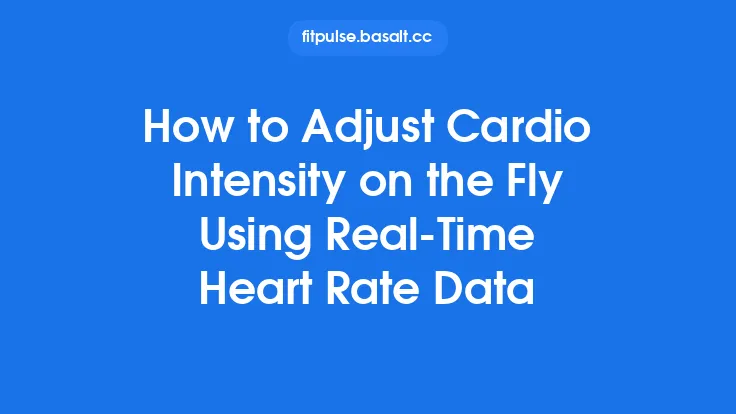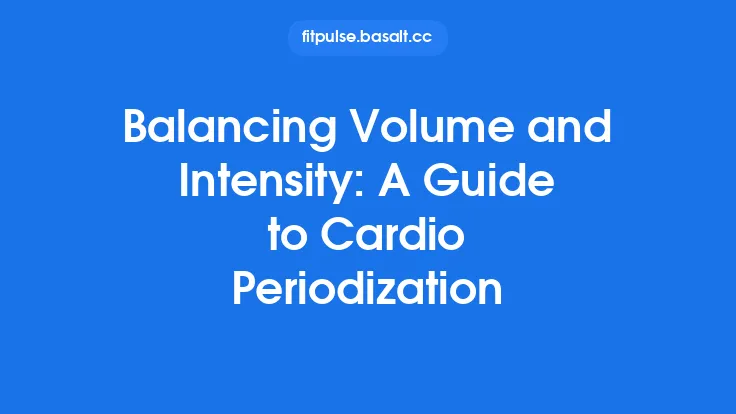Cardiovascular conditioning thrives on precision. While many athletes rely on “how hard it feels” to gauge effort, a more objective lens—heart rate zones—offers a reproducible way to monitor intensity, track progress, and align workouts with long‑term goals. By understanding the science behind heart rate responses, learning how to calculate personalized zones, and applying those zones strategically across training cycles, you can transform vague effort levels into data‑driven performance gains.
The Physiology Behind Heart Rate Response
When you exercise, your muscles demand more oxygen and nutrients, prompting the cardiovascular system to pump blood faster. This demand is reflected in the heart’s rhythm: each beat delivers a packet of blood (stroke volume) and the frequency of beats (heart rate) adjusts to meet metabolic needs. Two key physiological drivers shape this response:
- Sympathetic Activation – The “fight‑or‑flight” branch of the autonomic nervous system releases catecholamines (epinephrine and norepinephrine), accelerating heart rate to increase cardiac output.
- Parasympathetic Withdrawal – The “rest‑and‑digest” branch reduces its inhibitory influence, allowing the heart rate to rise more readily.
As intensity climbs, the balance shifts toward sympathetic dominance, producing a near‑linear rise in heart rate up to a point. Beyond that, factors such as stroke volume plateau, and heart rate continues to climb primarily through increased sympathetic drive. Understanding this relationship clarifies why heart rate is a reliable proxy for metabolic stress, especially when external variables (temperature, altitude, hydration) are stable.
Defining Heart Rate Zones – A Framework
Heart rate zones segment the continuum of effort into discrete bands, each associated with characteristic physiological responses. While the exact number of zones can vary (three, five, or even seven bands are common), the underlying principle remains: each zone represents a range of percentages of a reference value—most often the maximum heart rate (HRmax) or the heart rate reserve (HRR).
A typical five‑zone model looks like this:
| Zone | Approx. % of HRmax | Primary Adaptations |
|---|---|---|
| 1 – Recovery | 50‑60% | Enhanced circulation, active recovery |
| 2 – Endurance | 60‑70% | Aerobic base development, mitochondrial density |
| 3 – Tempo | 70‑80% | Lactate threshold elevation, improved stamina |
| 4 – Threshold | 80‑90% | High‑intensity aerobic capacity, VO₂ max stimulus |
| 5 – Max/Interval | 90‑100% | Anaerobic power, neuromuscular recruitment |
These percentages are not arbitrary; they map onto measurable shifts in blood lactate, oxygen consumption, and substrate utilization. By training within a specific zone, you deliberately stress the corresponding physiological system, prompting targeted adaptation.
Calculating Your Personal Zones
The cornerstone of zone‑based training is an individualized reference point. Two primary methods exist:
- Maximum Heart Rate (HRmax)‑Based Percentages
- Formulaic Estimate: A common age‑based equation (e.g., 220 − age) provides a quick approximation.
- Direct Measurement: Laboratory or field maximal effort tests (graded treadmill or cycle protocols) yield a precise HRmax.
Once HRmax is known, each zone is defined by a simple percentage range (e.g., Zone 3 = 70‑80% of HRmax).
- Heart Rate Reserve (HRR) – The Karvonen Method
HRR accounts for resting heart rate (RHR), offering a more individualized scaling, especially for those with unusually low or high RHR. The calculation proceeds as follows:
\[
\text{Target HR} = \text{RHR} + \bigl(\% \text{Intensity} \times (\text{HRmax} - \text{RHR})\bigr)
\]
For example, a 30‑year‑old athlete with an HRmax of 190 bpm and an RHR of 55 bpm targeting 75% intensity would compute:
\[
55 + 0.75 \times (190 - 55) = 55 + 0.75 \times 135 = 55 + 101.25 \approx 156 \text{ bpm}
\]
Both approaches are valid; the HRR method often yields zones that feel more “natural” because it incorporates the athlete’s baseline autonomic tone.
The Karvonen Method and Heart Rate Reserve
Why does HRR matter? Resting heart rate reflects chronic cardiovascular fitness and autonomic balance. Two athletes with identical HRmax can have markedly different HRR values, leading to divergent perceived effort at the same %HRmax. By anchoring zones to HRR, you:
- Normalize Training Load across individuals with varying RHR.
- Accommodate Seasonal Shifts: RHR can rise during illness or high‑stress periods; HRR‑based zones automatically adjust, preventing inadvertent over‑training.
- Enhance Precision for Endurance Athletes who spend extensive time in lower zones, where small absolute differences in bpm translate to significant relative intensity changes.
Implementing HRR requires a reliable RHR measurement—ideally taken first thing each morning, after a full night’s sleep, before any caffeine or activity.
Using Zones to Structure Training Phases
Periodization—systematically varying training stress—benefits from zone‑based scaffolding. A typical macrocycle (e.g., a 12‑week preparation block) might be divided as follows:
- Base Phase (Weeks 1‑4) – Emphasize Zone 2 work (60‑70% HRmax) to build aerobic capacity and capillary density. Sessions are longer, steady‑state efforts.
- Build Phase (Weeks 5‑8) – Introduce Zone 3 and Zone 4 intervals, raising lactate threshold and VO₂ max. A common pattern: 4 × 5 min at 75‑85% HRmax with equal recovery.
- Peak Phase (Weeks 9‑11) – Concentrate on Zone 5 high‑intensity intervals (90‑100% HRmax) to sharpen anaerobic power. Sessions become shorter but more intense.
- Taper (Week 12) – Reduce overall volume, maintain a few low‑intensity Zone 1–2 rides to preserve circulation while allowing full recovery.
By assigning specific zone targets to each phase, you ensure that training stress aligns with the physiological objectives of that period, minimizing the risk of “training in the wrong zone” and maximizing adaptation efficiency.
Zone‑Specific Workouts – What They Look Like
Below are illustrative session structures for each primary zone. Adjust duration and repetitions to match your fitness level and training phase.
- Zone 1 – Active Recovery
Duration: 20‑30 min at 50‑60% HRmax.
Purpose: Flush metabolites, promote blood flow without adding fatigue.
- Zone 2 – Endurance Cruise
Duration: 45‑90 min at 60‑70% HRmax.
Purpose: Enhance mitochondrial enzymes, improve fat oxidation capacity.
- Zone 3 – Tempo Run / Steady Ride
Structure: 30‑45 min continuous at 70‑80% HRmax.
Purpose: Raise lactate threshold, improve sustained speed.
- Zone 4 – Threshold Intervals
Structure: 4‑6 × 5 min at 80‑90% HRmax, 2‑3 min easy between sets.
Purpose: Push the point at which lactate begins to accumulate.
- Zone 5 – VO₂ Max/Power Intervals
Structure: 8‑12 × 30 s‑1 min at 90‑100% HRmax, equal or longer recovery.
Purpose: Maximize aerobic power and neuromuscular recruitment.
These templates can be mixed within a single week to create a balanced training load, provided the total weekly time in high‑intensity zones (4‑5) remains within the athlete’s recovery capacity.
Tracking Zone Time – Tools and Metrics
Modern training platforms (e.g., TrainingPeaks, Strava, Garmin Connect) automatically segment recorded heart rate data into user‑defined zones. When reviewing a workout, focus on:
- Time‑in‑Zone (TIZ) – The cumulative minutes spent in each band.
- Zone Distribution Ratio – Proportion of total session time allocated to each zone; useful for ensuring phase‑appropriate balance.
- Heart Rate Variability of Zones – While not a full HRV analysis, observing day‑to‑day fluctuations in TIZ can signal fatigue or adaptation.
For athletes without sophisticated software, a simple spreadsheet can log session date, target zone, actual average HR, and minutes spent within the target range. Over weeks, trends emerge, highlighting whether you’re consistently hitting prescribed intensities.
Adapting Zones Over Time – Re‑assessment and Progression
Your cardiovascular system evolves. As fitness improves, the same absolute heart rate may represent a lower relative intensity. To keep zones meaningful:
- Schedule Periodic Re‑tests – Every 6‑8 weeks, perform a sub‑maximal field test (e.g., a 5‑minute time trial) to estimate updated HRmax or lactate threshold.
- Monitor Resting Heart Rate – A sustained drop of 3‑5 bpm often indicates improved aerobic efficiency, prompting a recalculation of HRR‑based zones.
- Adjust Zone Widths – As you become more elite, you may narrow zones (e.g., 5% bands) to capture finer intensity gradations. Conversely, beginners benefit from broader zones to accommodate day‑to‑day variability.
Regular updates prevent “zone drift,” where workouts unintentionally become easier or harder than intended, thereby preserving the stimulus needed for continued adaptation.
Practical Tips for Consistent Zone Monitoring
- Warm‑up & Cool‑down Within Target Zones – Begin each session with 5‑10 min in Zone 1‑2, and finish similarly; this stabilizes heart rate and improves data accuracy.
- Account for External Factors – Heat, dehydration, and altitude elevate heart rate at a given workload. If conditions differ markedly from your baseline, consider using a slightly lower percentage to maintain the intended physiological stress.
- Use a Consistent Device – Heart rate sensors can vary in accuracy. Stick with a chest strap or validated optical sensor throughout a training block to ensure comparable readings.
- Set Alerts – Many devices allow you to program zone‑based alarms; a gentle vibration when you exit the target band helps you self‑correct in real time without over‑relying on constant visual checks.
- Log Subjective Feelings – Even though this guide avoids deep RPE discussion, noting a quick “easy/medium/hard” tag alongside heart rate data can later help you spot patterns (e.g., a session that felt hard despite staying in Zone 2 may signal fatigue).
Frequently Asked Questions
Q: Do I need a laboratory test to use heart rate zones?
A: No. While lab testing provides the most precise HRmax and lactate threshold values, age‑based estimates and field tests (e.g., a 20‑minute maximal effort) are sufficient for most recreational and competitive athletes.
Q: How does heart rate zone training differ from simply “running faster”?
A: Running faster is a speed‑based metric; heart rate zones tie effort to physiological stress. Two runners covering the same distance may have different heart rates due to terrain, temperature, or fitness level. Zones ensure the cardiovascular load is appropriate regardless of external variables.
Q: Can I use heart rate zones for strength training?
A: Primarily, zones apply to aerobic activities where heart rate reflects metabolic demand. For resistance work, other metrics (e.g., load, volume, RPE) are more informative, though a post‑set heart rate spike can indicate overall systemic stress.
Q: What if my heart rate spikes unexpectedly during a low‑zone workout?
A: Sudden spikes often stem from dehydration, caffeine, stress, or illness. Pause, hydrate, and assess. If spikes persist, consider re‑evaluating your resting heart rate and possibly adjusting zone thresholds.
Q: Is it okay to train exclusively in one zone?
A: No. A well‑rounded program cycles through multiple zones to develop the full spectrum of aerobic and anaerobic capacities. Over‑reliance on a single zone can lead to plateaus and imbalanced fitness.
By grounding your cardio sessions in scientifically derived heart rate zones, you transform vague effort cues into actionable data. This approach not only sharpens training efficiency but also provides a clear roadmap for progressive overload, recovery, and long‑term performance gains. Embrace the numbers, respect the physiology, and let your heart rate guide you toward the next level of cardiovascular mastery.




